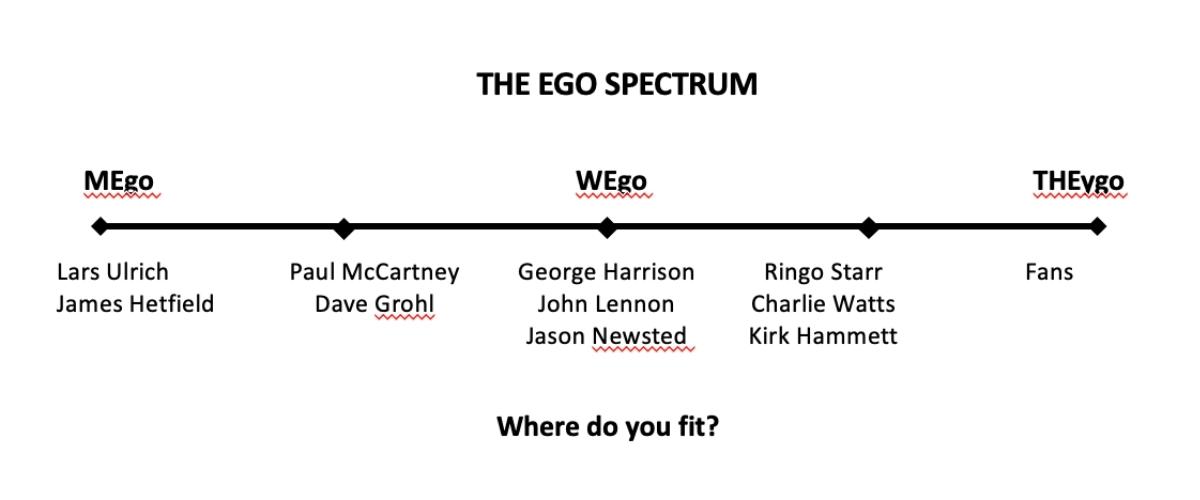News and Insights
Where’s Your Ego?
May 5, 2022
Inspired by The Beatle’s Get Back series (see my last blog post), I’ve found myself immersed in rock and roll documentaries over the last few weeks. From reading Dave Grohl’s The Storyteller (recommended by my brother, Drew) to watching Metallica’s Some Other Monster (recommended by my friend, Julian) and the Rolling Stone’s Gimme Shelter (thanks to my friend, Justin), I’ve enjoyed getting a glimpse behind the stage of these rock and roll legends.
All of these stories are fascinating examples of leadership, collaboration, team dynamics and the overall creative process. The lessons and insights that they offer are endless, but the one theme that struck a chord with me most (pun not intended) was the “ego” dynamic. While we all like to believe that we don’t have egos, the reality is that we all have one to some extent.
While my assessment is far from scientific, I came to imagine an “Ego Spectrum” where MEgos (it’s all about me) are on the far left, WEgos (it’s all about us) are in the middle, and THEYgos (it’s all about everyone else) are on the far right.

Of course, people can fall anywhere in the spectrum and can even change over time (or depending on the situation). However, understanding where people fall on the spectrum can help determine how/where/if they can best collaborate and contribute to a team. Perhaps someday, I’ll do a more comprehensive analysis but, until then, here is a shallow dive to get you thinking.
- MEgo’s need control. (Far left) Without it, they will break down. In the case of Metallica, especially after gaining status of being the most successful metal band in the world, two of the key members were definitely on the far left MEgo side of the spectrum (Drummer, Lars Ulrich and Lead Vocalist, James Hetfield). MEgos do not mix well with WEgos. Perhaps that’s why bassist Jason Newsted quit Metallica early on in the documentary. And more than one MEgo in a group can cause lots of chaos. Perhaps this is why the Metallica documentary ended up being more of a therapy session than a recording session.
- ME/WEgo’s move ideas forward. (Middle Left) This is where I’d put Paul McCartney. While he clearly likes to be in control, and has strength in his convictions (the MEgo in him), he’s also open to the ideas of others and recognizes that they’re all in it together (the WEgo part of him). Every great team needs someone in this area of the spectrum, as they tend to be the ones who push ideas forward (theirs or others). After much therapy, I believe Lars Ulrich and James Hetfield moved closer to this area. And, while his book doesn’t get much into the creative process, I imagine that Dave Grohl moved into this area as the leader of the Foo Fighters.
- WEGo’s are the ultimate collaborators. (Middle) Perhaps best personified by George Harrison, WEgo’s are confident in their skills and ideas but also open to those of others. They stand up for what they believe but don’t push it down other people’s throats. Based purely on the Get Back series, I’d also put John Lennon in this category. While he was clearly a genius songwriter, never once did you see him fighting aggressively for his ideas (although, perhaps they were so good, he didn’t have to).
- WE/THEYgo’s are always welcome on the team. (Middle right) Perhaps best personified by Ringo Starr, Charlie Watts and Kirk Hammett (Metallica Lead Guitarist), WE/THEYgo’s are the no-drama, let’s do this, team players. They are fully comfortable implementing good ideas from other people. They speak up when they disagree, but are fine going with the flow. They’re also comfortable sharing their own ideas, but don’t throw a fit when not implemented. They know it’s not personal.
- THEYgo’s can come or go. (Far right) Not surprisingly, there were no full-fledged THEygo’s in any of the groups I “analyzed.” Or, if there were, they didn’t make the documentary (aside from fans, potentially). These are the people who aren’t confident enough to share their own ideas and are generally accepting of all others. They make for good cheerleaders, but don’t really add much to the team.
Ultimately, everyone has some kind of ego and falls somewhere on the spectrum. I’d love to get your thoughts on this assessment and recommend taking a look at your team to see where each member sits along it. Perhaps it will provide some insight as to how they can better collaborate.
As always, I hope you enjoyed this post. Please feel free to share with others who you believe may find it of interest. And, I’d love to hear your thoughts and comments. In particular, I’d love to get your thoughts and feedback about how you see people behaving differently across the spectrum.
